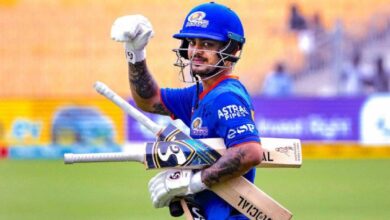Can the rising pair of Treesa Jolly-Gayatri Gopichand upset No. 1 ranked Chinese duo? | Badminton News

Two All England semifinals make Treesa Jolly and Gayatri Gopichand Pullela appear like they’ve been playing at this level forever. But 2023 is only just their first regular season, pitstopping at all big events on the seniors Tour.
Saina Nehwal and PV Sindhu spoilt India silly with their breakthrough seasons at age 18 in singles. But a closer look at the consent women’s doubles (WD) Top Ten bunch would tell you that mid-20s is when WD pairings hit the high notes. While pressure builds on Treesa-Gayatri to deliver the upsets and go deeper into tournaments every time they turn up on court these days, it becomes necessary to remember that they are still only just a pair of 20 year olds. But when the World No 19 Indians run into World No 1 Chen Qing Chen – Jia Yi Fan of China in Round of 16 at the Copenhagen World Championships on Thursday, the pressure to not get mauled in the scoreline, won’t subside from increasingly demanding Indian badminton followers. The Indian women will be expected to offer their strongest fight of the season.
There is pedigree there, and enough combined talent, but stepping up to return consent Top 10 scalps is still a season or two away at least if their relative strength and power compared to other pairings, is considered. In their Round of 32, they defeated Taiwanese 27-year-olds Chang Ching Hui and Yang Ching Tun, ranked No 37, winning 21-18, 21-10 in 38 minutes.
The Indians rotated reliably to defend well from the back, and were reasonably efficient in the cross game they employed from midcourt and the forecourt. Gayatri relied on placement to make up an early 5-2 lead for the Taiwanese, and 6-6 in the opener was working the right angles while attacking with speed on the opponents’ body. Later, both showed steadiness in defense from the back, though Treesa struggled a tad with length on the tight net returns when she surged forward – both on drops and the reverse flat drives. Gayatri would show how it’s done at 11-9, turning the racquet head oh-so-slightly at the last moment to get close to the tape cross.
Yang was displaying her vulnerability now to concede errors going for the angles and the lines, and Treesa directed her fast flats and crosscourt drives at her. The Indians would break away at 14-10 as Gayatri grew aggressive at the net, taking a stomping step or two across the forecourt to dish out the kills. At 18-15, the Indians would show good rotation skills as Treesa would come up to speed on the cross kills. When she was hitting down the middle, Treesa was effective, but going for the flanks, her precision wavered. Taiwan would serve out owing to the sideways drift to hand India a 20-16 advantage, and collect two more points. But Gayatri marshaling the front court would play a cross slice to draw out an error into the net as the Indians took the opener 21-18.
Coach Mathias Boe would urge the Indians to put 400 percent aggression behind each shot, and both women would up the ante going for body shots. Leading from the start, a Treesa hook winner to Taiwan’s forehand corner set the tone for the Indians. Gayatri meanwhile was pouncing on the second shot early, and creating pressure. Her powerplay and control of the rally, would double Yang’s errors into the net. A couple of backhands from either Indians would open up a nice 15-9 lead. The Treesa serve got a notch even better from here, and even Chang struggled to clear the net. On the final point a Yang backhand cross would go wide to give Indians a win in 38 minutes.
It is a critical transition time for young Treesa Jolly who while trying to gain speed on court coverage losing weight, is simultaneously trying to keep the strength of her hits intact. While the results are evident in how much better she’s moving in rotations, the wild big hitting is getting tempered and disciplined, as she looks for accuracy. Her front court game is still getting chiseled. For Gayatri, who was sharp on the day, the challenge remains to stay fit.
It’s why the big wins against top players will come intermittently and incrementally. This year, the slow, steady improvements are coming against the top Japanese pairings though losses pile up – against World No 4 Matsumoto Nagahara, the Indians went 22-20 in the second set at Australia. Against World No 7 Matsuyama – Shida, the losing score read 23-21, 21-19. Iwanaga- Nakanishi went to a decider. Most Read
1
Chandrayaan-3 landing live updates: Rover to come out soon after Vikram lander makes soft-landing
2
Chess World Cup 2023 Final LIVE: Praggnanandhaa and Magnus Carlsen agree to draw after 30 moves
See More
The wins came earlier in the year – at All England, Treesa-Gayatri beat World No 8 Kititharakul – Prajongjai in the opener, World No 5 Fukushima – Hirota in second round and World No 14 Chinese Li-Liu in quarters. At the mixed team Asia Championships, the Indians beat World No 17 Liu-Tan in three and World No 11 Thinaah Muralitharan and Pearly Tan in straight sets. Their ranking though has dropped to 19 from 14.
Consency will come with experience, and as they gain in strength. The current top tenners average 26.35 years, and it takes a few seasons’ time to step up from Top 20 to Top 10. Consider the ages of the big names in WD today – Chen Qing Chen – Jia Yi Fan, both are 26 year olds, while Baek Ha Na 22, Lee So-hee 29, Kim 31, Kong 26, Matsumoto 28, Nagahara 27, Fukushima 30, Hirota 29, Zhang 23, Zheng 27, Matsuyama 25, Shida 26, Kititharakul 30, Prajonjai 30, Benyapa Aimsaard 20, Nuntakarn Aimsaard 24, Jeong 23 and Kim Hyae-jeong is 25. The Indians will only get better as the years roll on.
Still, the Indians suffered some scarring one-sided scorelines against Koreans Baek Ha Na – Lee So-hee, and their first goal against the Chinese top ranked pairing will be to make a fight out of this opportunity. The big stage demands calm nerves, while the 20-year-olds express themselves, attack fearlessly and defend resolutely when the shuttle comes flying at them.







